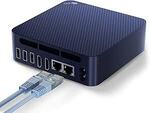The latest version of Beelink's quiet EQ13 mini PC but with a refreshed processor. Reviews say the N150 is only a small performance increase from the N100 with a higher TDP (6 W vs 10W(cpu-monkey.com)), but given the EQ14 with 16GB RAM and 1TB storage is on sale for $299.20 currently and the OzB ATL for the EQ13 with N100 CPU, 16GB RAM and only 500GB storage is $329 I think this is a great deal.
The EQ14 with 16GB RAM and 500GB storage is $10.20 cheaper but imho not worth saving 10 buckaroos.
The S12 Pro with N100, 16GB RAM, 500GB SSD is $259 but I’d prefer the EQ14 since it’s known to run silently and has dual Ethernet. S12Pro: https://www.amazon.com.au/dp/B0C1N5287T
The S13 Pro with N150, 16GB RAM, 1TB storage is also $299 but again I’d prefer the EQ14. S13Pro: https://www.amazon.com.au/dp/B0DPQC6DRV
Some reviewers have had minor driver issues with Linux though, there's a pretty good breakdown here: https://www.youtube.com/watch?v=c8MUCR0u_7A. TL;DR you may need to go onto non-LTS Ubuntu or beta for hardware acceleration on Proxmox(reddit.com)
Specs:
⚡【Latest Intel Alder Lake-N150】The EQ14 mini pc features 2024 latest Intel processor Alder Twin-N150 (4C/4T, up to 3.6 GHz, 25W TDP Max). Low power consumption and compact size makes the mini computer the first choice for light office work, 4K video playback, online training, design and much more.
⚡【Powerful Memory & Expandability】Mini PC with high-speed 16GB DDR4 memory and 1TB M.2 2280 SSD. This mini PC is perfect for everyday work and content creation. It provides powerful storage without severely draining system resources. Plus, You can expand storage to 2TB by adding an M.2 2280 SSD (NVMe/SATA).
⚡【4K Ultra HD Display】 Beelink N150 is equipped with UHD Graphics 24EUs 1000MHz, supports 4K video playback, providing smooth and gorgeous visual effects. You can also connect this mini PC to a projector to create a home theater and enjoy all kinds of entertainment. The Dual HDMI Mini PC allows you to connect two monitors simultaneously, simplifying and increasing your productivity.
⚡【Dual 1000M LAN & Wifi6】Beelink N150 has dual 1000M Ethernet ports that enable fast data transmission to meet your daily needs. Built-in WiFi6 (Intel AX101) and BT5.2, delivers a faster and more stable internet experience for you.
⚡【Satisfactory service】 Beelink mini pc will be delivered to customers only after strict inspection. Customer support makes our products better, which is our motivation to continue to bring better products to customers. Provide one year warranty, if you have any questions, please contact us.




 CamelCamelCamel
CamelCamelCamel

Can this be used to connect to a NVR, and then wirelessly to a guest wifi network? Thinking to use this as a temp solution rather than spending similar amounts for a router eith VLAN that are expensive
Potentially in the future, may use this to run blue iris